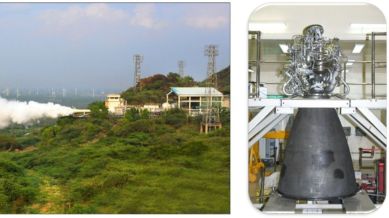Cryogenic engine for human spaceflight mission, Gaganyaan, tested successfully: ISRO
Gaganyaan is India's proposed first human flight mission that envisions sending a three-membered crew into an orbit of 400km for a period of three days and bringing them back to Earth.

The Indian Space Research Organisation (ISRO) on Wednesday said that the performance of the key cryogenic engine to be used on board the LVM3 launch vehicles for India’s Gaganyaan missions, has been qualified and now certified for missions that will transport humans into space.
Gaganyaan is India’s proposed first human flight mission that envisions sending a three-membered crew into an orbit of 400km for a period of three days and bringing them back to Earth. The first unmanned Gaganyaan – 1 mission is scheduled sometime in mid-2024.
ISRO’s heavy lift launcher, the LVM has been identified as the launch vehicle to be used during the Gaganyaan missions. Comprising solid, liquid and a cryogenic stage, these systems can be configured to ferry humans into space.
The seventh in the series of vacuum tests performed on the CE20 cryogenic engine, which powers the space vehicle during the cryogenic stage of its lift-off, was performed on February 14 at the space agency’s High Altitude Test Facility in Mahendragiri in Tamil Nadu.
“ISRO has accomplished a major milestone in human-rating of CE20 of the LVM3 vehicle for Gaganyaan missions,” the ISRO shared on its ‘X’ handle on Wednesday.
Previously, the CE20 was subjected to 39 hot firing tests under varying operating conditions that lasted for 8,810 seconds (2 hours 26 minutes), whereas the minimum standard time for human rating is 6,350 seconds (1hr 45 minutes).
ISRO further said that even the flight engine, identified for the first Gaganyaan mission, has completed the acceptance tests. Powering the upper stages of the LVM3, the flight engine boasts of a thrust capacity of 19-22 tonnes with an impulse of 442.5 seconds.
The development of a human-rate launch vehicle is part of the several tests and technology development efforts required for the proposed human-space flight mission. Other technological developments such as development of life support systems to provide an earth-like environment to crew in space, crew emergency escape provision, evolving crew management aspects for training, recovery and rehabilitation of crew are planned. Besides, precursor missions are being planned which will demonstrate the technology preparedness levels before the actual manned Gaganyaan mission.